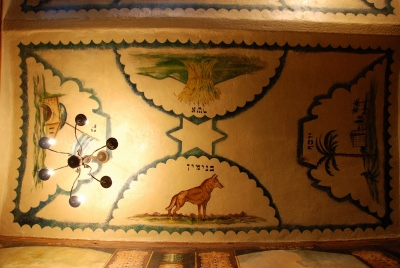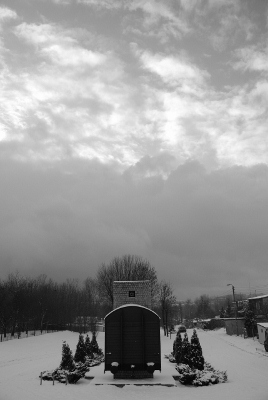News from Galicia
SCHINDLER'S FACTORY - Cracow under the German Nazi occupation from 1939 to 1945
In summer 2010 the Krakow's Historical Museum opened its new branch at the premises of the former Schindler’s Factory. This modern museum is to present the history of Krakow under the German Nazi occupation from 1939 to 1945. Large part of the exhibition is devoted to show life and annihilation of the Krakow’s ghetto. The museum is arranged chronologically, giving the visitor a unique opportunity to follow the war time narration and experience of occupation reality. The numerous artistic means and multimedia presentations enrich the exhibit and help to understand the complexity of Nazi occupation of Krakow and Poland. The first part of the exhibit narrates the city's cultural, ethnic and religious richness in the 20’s and 30’s of the XX century. Stereographic pictures take us into the streets of the city just before the war. Then comes the September Campaign and gradual implementation of the new Nazi regime aimed against local population. The museum creators were able to reconstruct city's streets, prison cells, war time apartments with an successful effort to show general anxiety, chaos and individual human tragedy inflicted by war. The exhibition has many layers of narration and in this way can satisfy people who want to have just a general orientation in the war time in Cracow as well as history experts looking for some additional history details.
We offer certified guides and tours at the Museum in the former Schindler's Factory - "Krakow under the German Nazi occupation from 1939 to 1945".
MARKET SQUARE/RYNEK UNDERGROUND - Following the traces of the European identity of Kraków
In autumn 2010 the Historical Museum of the City of Krakow opened its brand new exhibition in the excavated undergrounds of the Market Square and Cloth Hall building. This museum is the result of many years of archeological works undertaken in the very core of 1000 years history of Krakow and close to 800 years since its location. The archeologists reached the base level, indicating the first human activities in this area around 8 meters below the present surface of the market.
The museum encompasses 700 archeological pieces, 500 digital models of buildings, 600 3D digital models of city structures in the time span of last 1000 years. During a visit we can admire medieval city stalls, cemeteries, cobblestone streets, jewelry and hundreds of artifacts well enhanced and enriched with multimedia presentations, 3D models and holograms. This new branch of the Krakow's Historical Museum provides a time vehicle across the last ten centuries of the city's history and makes every visitor feel the growing, accumulated city's beauty and potential. It will definitely become the main attraction for both inhabitants and tourists.
MIZRAHI SYNAGOGUE IN BĘDZIN was re-opened after five years of renovation works
In early 2012 the city of Będzin has finished the five years renovation project of Mizrahi synagogue in the city. This XIX century synagogue was established by Będzin merchant Jakub Chil Winer in the basement of his house. The synagogue was the only one surviving the Holocaust in the city. It was re-discovered by local history enthusiasts in 2004, but its interior was very badly damaged with polychromies pealing off.
In the last five years the city has invested over 120.000 PLN in restoration project. Now the interior is brought back to its colorful and splendid shape. The polychromies are following Zionist , religious narration by depicting holy sites of Israel with some religious symbols and signs of Zodiac inserted. This unique synagogue will become another focal point for Zaglebie (Będzin, Sosnowiec and Dąbrowa) Jews in the world.
Ceiling of the Mizrahi synagogue in Będzin after renovation.
Monument of Deportations of Bedzin Jews in 1943 to Auschwitz.
Kazmierz Smoleń the former prisoner of Auschwitz-Birkenau number 1327, and long time director of the Auschwitz-Birkenau Museum passed away on January 27th,2012.
Kazimierz Smoleń the former prisoner of Auschwitz-Birkenau, and long time director of the Auschwitz-Birkenau Museum passed away on January 27th,2012. Kazimierz Smoleń was arrested in April 1940, deported to Auschwitz on July 6th, 1940 he was given a KL Auschwitz number 1327. He survived the camp for the next almost five years. On January 18th, 1945 with Auschwitz evacuation he was deported to Mauthausen. Finally Kazimierz Smoleń was liberated on May 6th,1945 in Ebensee, a sub camp of Mauthausen, over 5 years after his imprisonment. After the war he was working in the Commission to Investigate the Nazi Crimes in Poland and participated as a witness and expert in trials of SS staff of Nazi Concentration Camps. Kazimierz Smoleń was one of the creators of the State Museum Auschwitz-Birkenau established in 1947 and from 1955 till 1990 he served as the director of the Museum. After retirement he was still devoted to the Auschwitz education and worked witnessing about the camp history to younger generations till his very last days. Blessed be his memory.
70th Anniversary of the Nazi Wansee Conference and initiation of the mass extermination of Jews in Death Camps
January 20th, 2012 was the 70th anniversary of Wansee Conference at which the German Nazis took the decisions about the ultimate shape of the "Final solution to the Jewish question" in Europe. There were 15 high ranked German Nazis participating in Wansee, at least eight of them with PhD titles. Within a few weeks after the conferance the first mass transports of Polish Jews were sent to Death Camp of Belzec. The first mass transport of Jews to Auschwitz arrived on March 26th, 1942 from Slovakia.
Page 6 of 8






